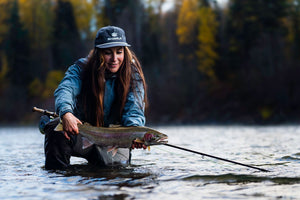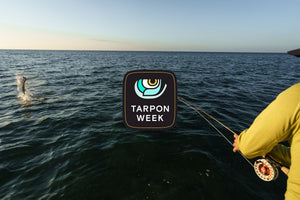Tarpon get around. We mean that in the literal sense, not the biblical. These fish move. Fisheries biologists still don’t know all that much about their reproductive habits, though they’re thought to be broadcast spawners, so they probably “get around” in the other sense too.
Tarpon start life as a creepy looking mini-eel, called a leptocephalus, about 100 miles offshore. These little jelly-worms swim and drift their way landward and then sneak into estuaries at night through the shallowest cuts they can find to avoid getting eaten by, well, everything. Then they find a stagnant, brackish backwater and hide out for a few years. Tarpon “gulp” air and can absorb oxygen through their swim bladders, which allows the juveniles to live and grow in places that are inhospitable to other fish that might eat them. That’s a pretty solid evolutionary strategy, which is probably why tarpon have been around for at least 50 million years.

Prehistoric tarpon dodged mosasaurs; you think your 12 weight scares them?
Once they hit four feet long, or so, tarpon head back out into the ocean, because at that point nothing scares them other than big-ass sharks. If you’ve ever been on a tarpon flat while a train car hammerhead patrols the perimeter, you’ve seen that fear.
For the most part, though, they do what they want and go where they want, though we’re still not exactly sure where they go or why. Tarpon have been found as far north at Nova Scotia, as far east as France, and as far South as Argentina. Researchers have observed 1200-mile migrations—roughly the distance between Florida and New York City—and yet some individuals spend their entire lives (sometimes more than 50 years) in a 100-mile radius. They’re ancient and mysterious, and no matter what anyone tells you they are NOT giant herrings. Their only living relatives are ladyfish.
While there are technically two species of tarpon, Atlantic and Indo-Pacific, only the Atlantic variety gets much attention. The Indo-Pacific flavor doesn’t grow nearly as big. When you picture a tarpon, the glittering image you have in your mind is Megalops atlanticus. And that’s not just a clever name, Atlantic tarpon live in the Atlantic and Caribbean.
So why did large tarpon start showing up in Panama Bay—the Pacific Ocean—in the late 1930s? In case Central American geography isn’t your strength, check out Google Maps. You’ll notice that Panama Bay is close to the Caribbean as the crow flies but separated from the Atlantic by that little strip of land. Did tarpon go all snakehead and crawl between oceans, leaving a trail of mayhem and dismemberment in their wake? (Click the snakehead link to get the joke. Or this one if you want more.)
No. In 1914 the Panama Canal created a shipping shortcut for vessels to avoid the long, dangerous journey around Cape Horn, between Tierra del Fuego and Antarctica. It also opened a new fish passage from the Atlantic and Pacific Oceans. Most oceanic fish, however, can’t take advantage of that corridor, because it passes through the freshwater Gatun Lake. Remember how tarpon survive as juveniles? The same evolutionary adaptation that allows them to hide in brackish backwaters gives them the unique ability to traverse the Panama Canal. Adults found a fertile foothold in the Pacific and have been caught from Guatemala to Ecuador. The world’s biggest tarpon may now be swimming in a totally different ocean thanks to a man and a plan. Recent studies suggest that tarpon are now reproducing on the Pacific side, though none of the little eel babies have yet been found, suggesting that spawning success is probably limited.
Despite their incredible resilience and evolutionary success, tarpon numbers are declining worldwide. If you’re an angler (and if you’re reading this, you ARE an angler) that’s a problem. Monte Burke explains the situation in this new article published in Garden and Gun. It’s worth your time.
Fascinating as all those tarpon facts may be, the truth is that you (and we) only care about tarpon because they’re so much damn fun to catch, especially on a fly rod. If you’ve done it, you know. If you haven’t, why not? Whether you want to prove yourself in the tarpon mecca of the Florida Keys, find unpressured fish on the flats of Cuba, pull juveniles from the mangroves of Mexico, or explore the jungles of eastern Costa Rica, we know people who can get you on fish.
When you go, make sure you’re fully prepared with our SOL Collection, the finest sun-gear you’ll find. We’ll keep you cool, comfortable, and protected from the sun and heat.

